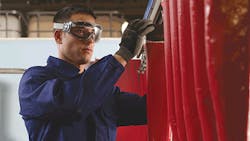Safety spectacles, goggles and sealed eyewear come in a multitude of styles, and most meet ANSI requirements for impact protection. Each choice offers pros and cons, particularly when chemical hazards or fine particles are present in the workplace.
For example, spectacles leave a gap between the lens and the face, allowing fine particles, flying objects and chemicals to reach the eyes. They are not suitable for use in high-particulate environments or among chemical hazards.
Sealed eyewear, which combines the low-profile styling of spectacles with the sealed fit of a goggle, is ideal for protecting against impact as well as dust and airborne debris. However, because liquid can soak into the foam that rests between the frame and the face, sealed eyewear is not a safe choice if chemical splash hazards are present.
Only safety goggles provide a complete seal around the eyes, conforming to the wearer's face to prevent liquids from seeping into the eye area. For this reason, goggles remain the top choice of many safety managers in environments where hazards include chemical splash. Since they also protect from impact, airborne particles and flying debris, goggles deliver superior overall protective performance.
Applications for Goggles
According to the ANSI Z87.1-2010 standard for eye and face protection, workers should be outfitted with safety goggles in a wide array of applications where impact, heat and chemical splash hazards are present. Goggles routinely are worn by individuals working in the chemical, oil and gas, and food processing industries, for instance. However, chemical splash hazards exist in nearly every industry, most commonly wherever cleaning or maintenance activities are conducted. From chipping, grinding and machining, to welding and furnace operations, to chemical handling, degreasing and plating, the added protection of a goggle is recommended.
When the eyes are not properly protected, resulting injuries can include corneal burn, abrasion or penetration, and outcomes range from temporary or permanent vision loss to the loss of an eye.
Injuries are costly to employees and employers alike, and few would disagree that protecting workers' eyes should be at the top of every safety manager's list. Yet navigating the wide variety of styles and options of eye protection can seem daunting. This article looks at key considerations in selecting effective safety goggles so your workforce can focus on the task at hand rather than their personal protective equipment.
Types of Safety Goggles
There are three standard types of safety goggles:
- Indirect-ventilation goggles feature an angled, vented portion that does not allow for direct, straight-line passage from the exterior to the interior of the eyewear. For this reason, indirect-vent goggles ideally are suited for acid and chemical handling as well as degreasing and plating activities. A versatile choice, they also are suitable for wear among hot sparks, as well as under face shields where high-temperature exposure or splash hazards from molten metal exist.
- Direct-ventilation goggles feature front-facing vents that, according to ANSI, must be capable of excluding spherical objects measuring 1.5 millimeters (0.06 inches) in diameter or larger. Like indirect-vent goggles, this style is ideal for protecting from impact hazards and airborne dust and debris, and safely may be worn under face shields in high-heat applications. However, since they may allow chemicals to splash into the vents and make contact with the eye, direct-vent goggles are not appropriate for use among chemical splash hazards.
- Closed-vent goggles, which do not have vent openings, are suitable for applications where impact, airborne debris and chemical splash hazards are present. No matter which type you select, safety goggles must bear the ANSI marking on both the lens and the frame to ensure compliance with national safety standards.
Fogging
The overall design of a goggle affects not only its ability to protect from different types of hazards but also the amount of airflow that can circulate around the lens to help deter the natural force of fogging.
Just as with safety spectacle lenses, goggle lenses fog as a result of rising body temperature during exertion and environmental factors such as heat and humidity. The open design of spectacles allows air to flow across the front and back of the lens, moving heat and moisture away and helping deter fogging. In the case of goggles, however, the tight seal against the wearer's face restricts air flow, making fogging a much greater challenge.
The effects of obscured vision from fogging can be catastrophic. It only takes a second for an accident to occur – a misstep, slip or fall; contact with machinery; getting struck by equipment; or coming into contact with chemicals or electrical current. Therefore, a top consideration when selecting goggles should be identifying a proven and effective anti-fog coating.
Because fogging is the No. 1 challenge faced by safety eye protection users, manufacturers constantly strive to make advances in anti-fog coatings and lens technologies for improved performance. Keep an eye toward new and improved anti-fog solutions that enable even longer-lasting fog-free vision to reduce distractions and deliver the greatest safety.
Lens Options
Another lens technology that prolongs a clear, safe view for workers is anti-scratch coating. When goggle lenses become scratched or worn, the distorted view can cause headaches, eye strain and fatigue, hindering worker safety and productivity. Applied to the outside of the lens, anti-scratch lens coatings reduce scratching to ensure a high level of optical clarity and extend lens life in dirty, high-particulate environments.
When scratching is unavoidable, goggles with optional replacement lenses are an economical approach. By selecting goggles with replacement lenses, workers quickly and easily can swap out worn lenses for new ones, without incurring the cost of replacing the entire goggle.
Finally, lens tints should be considered to help reduce eye strain caused by environmental factors, specialized lighting or infrared hazards. For instance, in bright outdoor environments, grey lenses help reduce the effects of glare, while for welding-related work, shade 3 or shade 5 lenses should be selected based on the application. Whether tinted or not, nearly all safety lenses deliver at least 99 percent ultraviolet protection.
Comfort and Fit
As with any form of PPE, the comfort and fit afforded by safety goggles play a key role in supporting compliance. Uncomfortable goggles will cause pressure points, leading the worker to remove them to make adjustments or leave them off completely – even in the presence of hazards. Alternatively, the more comfortable the eyewear, the more likely a worker is to leave it on all day.
Once the proper level of protection is identified, goggles can be selected based on style and fit. The most important factor is that the goggle provides an uninterrupted seal around the face that is comfortable and free from pressure points. This is achieved in part by selecting goggles made with good-quality, soft material that conforms to the individual's facial features. Peripheral vision is another important factor in worker safety, so keep an eye toward styles offering a large, wide viewing area.
To achieve a comfortable and personal fit across the workforce, look for goggles with adjustability features. Pivoting straps, for instance, offer flexibility in the angle at which the goggle is worn and allow the band to sit higher on the back of the head. Also keep in mind that goggles often are worn in combination with other forms of PPE. A streamlined goggle style with an adjustable band angle may fit better when worn in combination with other forms of PPE such as hardhats or welding helmets. Finally, if workers require prescription eyewear, look for goggle styles that allow comfortable over-the-glass (OTG) wear.
There are many considerations in selecting the right eye protection. When it comes to protecting workers against impact, airborne-debris and chemical hazards, goggles offer the greatest coverage and can make the difference between a recordable injury and another safe day on the job. By understanding the styles and technologies available, you can support your company's safety record while bolstering its culture of safety. That's a winning strategy on which everyone can see eye-to-eye.
Dave Iannelli is senior product manager for Uvex Safety Eye Protection, Honeywell Safety Products.

